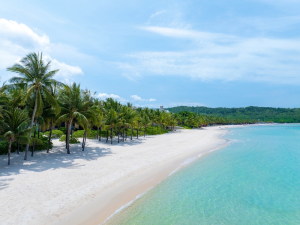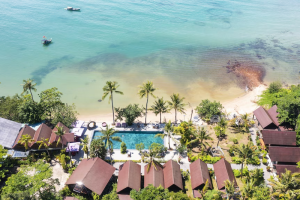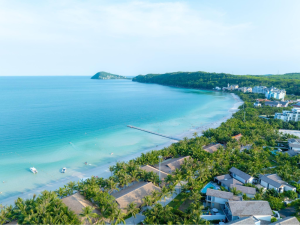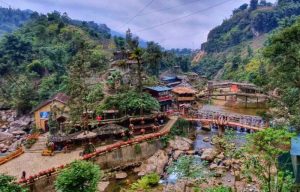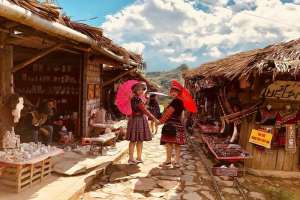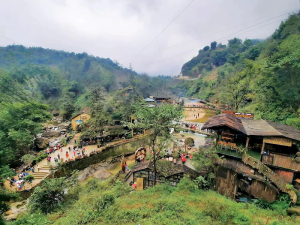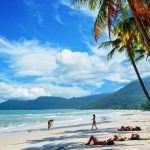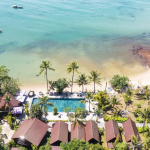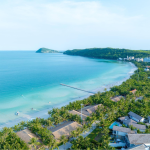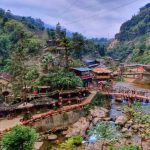Mu Cang Chai weather varies significantly from season to season, so it’s best for travelers to be aware of the yearly climate trend prior to visiting. No matter if you’re wishing for golden rice fields, misty mountains, or dry trekking trails, the weather will determine your experience. Located in the northwest Vietnam highlands, Mu Cang Chai experiences dry and rainy seasons with a different atmosphere and experience in each. In this article, we bring you the weather by season, travel time suggestions, and handy tips to better prepare you for your trip. Get ready to travel to Mu Cang Chai with the weather on your side.

Current weather in Mu Cang Chai
The weather today in Mu Cang Chai is warm, cloudy, and extremely humid. The rainy season, which runs from May to October, has frequent rain showers and high humidity, typically with dew points in the 78°F range, and occasionally as high as 90°F in some localized areas. This makes the air heavy and wet, which could be unpleasant for tourists, especially with extended periods of time outdoors.
During the warmest summer months, the temperature tends to go over 25°C (77°F) and can even get as high as 39 °C (102°F) during heat waves. The high humidity combined with such heat can increase heat stress, so it is extremely recommended to keep yourself hydrated and dressed in lightweight, loose clothing. Rainstorms are a daily occurrence – often sudden and heavy, sometimes with whirlwinds or flash flooding – so a functioning rain jacket and waterproof footwear are essentials for the current weather.

Mu Cang Chai weather by season: What to expect
Understanding the Mu Cang Chai weather through the seasons helps travelers prepare for the climate and plan their activities:
Winter (December–February)
Winter is dry and cold, with average temperatures below 20 °C (68 °F) and nights sometimes getting close to freezing. Frost is common, and occasional snowfall can be felt on the higher peaks. Late winter is marked by gentle drizzle, misty trails, and a peaceful off-season experience ideal for those tourists who don’t mind cooler climates.
Spring (March–May)
The temperature ranges from 15 °C to 28 °C (59–82 °F), with pleasant daytime warmth. Intermittent spring rain showers greenery and bring blooming seasons with peach, plum, and mustard flowers covering the hillsides. Ideal for light trekking and cultural experience during Khau Pha Pass and spring village festivals.

Summer/Monsoon (June–August)
The wet season hits its peak with hot, humid weather – temperatures are 25–32 °C (77–90 °F), with occasional highs above 38 °C (100 °F). Heavy daily rains keep the rice terraces green and lush but cause dangers of slippage, flash floods, and road washouts. With proper gear like waterproofs and sturdy footwear, it’s still possible to visit, but with care.
Autumn (September–November)
Autumn is the season of milder, drier weather with temperatures of 15–26 °C (59–79 °F). September records around 22 days of rain with a total of around 192 mm, along with high humidity (~81.6 %). Golden harvest terraces are witnessed between mid-September and early October, along with clear skies – the ideal time for photography and outdoor festivals.
Best time to visit Mu Cang Chai for good weather

Choosing the best time to visit Mu Cang Chai largely depends on what you want to see and experience, influenced heavily by the Mu Cang Chai weather:
- Watering season – May to June: Also known as the planting season, this is the time when the terraces are flooded and reflect the skies, creating a stunning mirror‑like effect. Daytime temperatures typically sit between 22–28 °C, with cool mountain winds and a bit of light rain. It’s an ideal time for photography and observing local farming ceremonies without the tourist crowds.
- Green season – July to August: Bright green carpets of young rice crops cover the terraces. Temperature and rainfall increase, but sightseeing remains pleasant, especially for nature lovers and trekkers.
- Harvest time – mid-September to mid-October: Considered the high tourist season. The paddies are a rich gold, and the climate is pleasant (15–26°C) with fewer heavy rains than during summer. Cultural activities also peak, with chances to see ceremonies and festivals surrounding rice harvesting.
- Dry season – November to March: Cooler, drier weather with some frost. While terraces will be brown and agricultural activity winds down, the period offers tranquility, fewer obstructed trekking routes, and an off-the-beaten-path cultural experience.
How Mu Cang Chai weather affects travel and outdoor activities

The region’s Mu Cang Chai weather significantly shapes both the practicalities and experiences of travel and outdoor adventures:
1. Trail and road conditions
The rainy season (April–October) experiences heavy downpours that can turn trails to mush, cause mud, and induce periodic landslides or flash flooding, making motorbike travel and hiking a challenge. The weather in the dry season is more stable, with harder roads and safer hiking.
2. Scenic variations
- Watering season: Terraces are full of water; excellent for sunrise/sunset photography with reflections.
- Green season: Lush landscapes provide verdant visuals.
- Harvest season: The golden fields provide lifetime photography opportunities.
3. Comfort and temperature
- Wet season: High humidity and heat (25–32 °C, sometimes up to 39 °C) demand breathable clothing, hydration, and frequent showers.
- Dry season: Cooler weather, especially from November to March, calls for layers; early mornings can drop near freezing.
4. Cultural and festival experiences
The Khau Pha Paragliding Festival in May–June provides your journey with a bird’s-eye view. The Terrace Field Festival in September celebrates harvest rituals and local traditions, enhancing the journey with cultural experiences.
5. Travel logistics
It’s recommended to pre-book accommodation and transport ahead of time in the high seasons (May–June and September–October), since these periods coincide with the area’s peak travel seasons. During the low season (winter), expect more availability but also reduced services.
6. Safety considerations
Monsoon rains can cause flash flooding and treacherous trails. Waterproof gear, sturdy hiking boots, and careful planning according to weather reports are essential. The dry season, however, offers safer and more pleasant trekking with blue skies and more solid infrastructure.
Read more: Ta Chi Nhu: One of the best mountain to hunt cloud
Weather forecasting tools and tips for Mu Cang Chai
To make the most of your visit amid Mu Cang Chai weather, using reliable forecasting tools and smart planning can make all the difference.
1. Use trusted weather platforms
Sites and applications like Weather.com, AccuWeather, or ClimeRadar provide credible hourly and 10-day forecasts for Mu Cang Chai. These sites offer basic information, including temperature, humidity, probability of precipitation, and radar, which is essential when it comes to preparing for rain showers and thunderstorms.
2. Monitor monsoon season alerts
From May to September, Mu Cang Chai weather often experiences thunderstorms, flash floods, and road washouts. Lily’s Travel recommends keeping a close eye on the weather during these months since rain is intense and sporadically spread. Real-time mobile app warnings are necessary to avoid dangerous conditions.
3. Check historical and seasonal climatic data
Sites like Vinpearl or Autour Asia offer climatology insights: annual average precipitation (~1,800–2,000 mm), summer high humidity, and temperature variations between 0–39 °C. Understanding these trends helps tourists choose good times for activities like trekking or photography.
4. Set up real-time notifications
Most weather apps allow you to receive alerts for rain, storms, or floods. Choose to receive notifications to warn you before you head out for a sunrise hike or mountain pass trek.
5. Build buffer days around unpredictable weather
Develop flexibility within your schedule – this lets you shift outdoor activities around as forecasts change. An unexpected afternoon thunderstorm can ruin planned trail hikes or vista viewing if you’re not flexible.
6. Pack smart for varying conditions
- Waterproof clothing and rain covers
- Quick-dry layers to handle morning fog or midday showers
- Waterproof hiking boots and sealed bags for cameras and electronics
- Lightweight warm clothes for cooler nights and early mornings
7. Observe local advice and guides
Ask your local tour operators or homestay hosts for daily weather updates. Many have first-hand knowledge of microclimates and terrain-based tips, especially on routes prone to flooding or landslides.
8. Include radar in your weather checks
Radar image applications (e.g., ClimeRadar or Weather.com) show impending storm cells and areas of precipitation – handy for plotting travel routes in advance of rain.
| Item | Purpose |
| Weather app alerts | Notifies you of rain and flood conditions |
| Weather radar tool | Visualizes approaching storms |
| Backup planning days | Avoid missing key activities due to rain |
| Proper gear | Stay dry and comfortable during wet spells |
| Local advice | Benefit from regional forecast adjustments |

Act now – secure your spot with Lily’s Travel! Since our founding in 2007, Lily’s Travel has grown into a premier tour operator in northern Vietnam, earning over 2,000 five‑star TripAdvisor reviews. Our mission is to connect you deeply with Vietnam’s cultural tapestry through tours across Vietnam, Laos, and Cambodia, highlighting multi‑ethnic traditions and natural beauty. Our innovative, community‑driven approach emphasizes sustainable tourism, while our dynamic young team uses 4.0 technology for stunning 3D tour previews. Choose Lily’s Travel for professional guidance, authentic experiences, and memorable adventures that support local communities.
Mu Cang Chai weather shapes every moment of your journey, from misty mornings among the terraces to golden sunsets over harvest fields. By understanding seasonal patterns, monitoring reliable forecasts, and packing the right gear, you can embrace both rainy and dry seasons with confidence. Whether you chase reflective waters in June or vibrant golds in October, planning around Mu Cang Chai weather ensures smoother travel, safer adventures, and unforgettable memories in Vietnam’s highland gem.
Read more: Hanoi to Mu Cang Chai – Travel smart & save money



